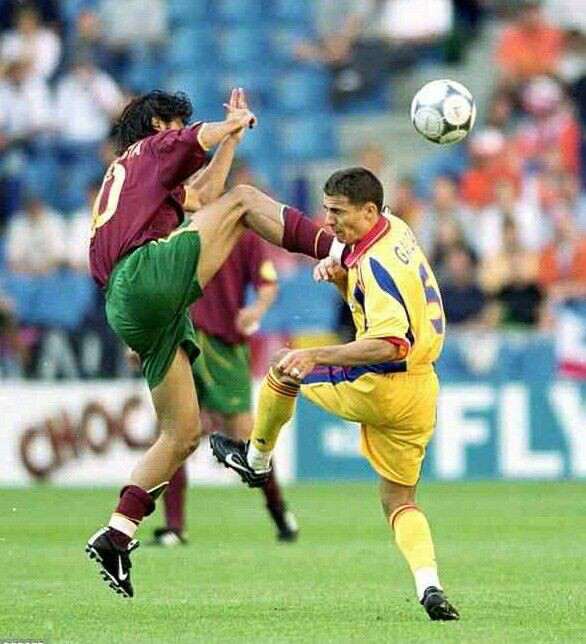Injuries are very common in football. Each time players step onto the pitch, they know there is a risk of getting injured and it can even be a very terrible one.
Footballers work hard in training and in the gym to put themselves in a position where they could decrease the risk of injuries.
Whether it’s through stretching, exercise techniques or nutrition, they try to minimize the chances of suffering an injury.
But no matter how hard players train, an injury can happen at any time and often without warning. Perhaps a player gets tackled, makes a quick cut around a defender, falls awkwardly or slips while running with the ball; his season or career could end in a snap.
Here, FootballOrbit compiles 11 terrible football injuries that regularly occurs and players can’t heal from them with just an ice pack.
1. Anterior Cruciate Ligament (ACL) Damage
Estimated Recovery Time: 6 to 9 months
The Anterior Cruciate Ligament (ACL) is one of the strong bands of tissue that help connect the thigh bone (femur) to the shinbone (tibia).
ACL injuries most commonly occur during sports that involve sudden stops or changes in direction, jumping and landing.
In football, ACL injuries can be caused when a player makes a rapid change in direction, a sudden stop or slowing down when running or even direct contact through tackling.
Recovery from this terrible injury takes about 6 months or more. Due to the after affects and risk of re-occurrence, this can prove to be a horrible injury to get rid of.
Footballers may hear a pop or feel a “popping” sensation in the knee when an ACL injury occurs. The knee may swell, feel unstable and become too painful to bear weight.
2. Achilles Tendon Tear/Rupture
Estimated Recovery Time: Tear 6 to 12 weeks. Rupture 6 to 12 months
The Achilles tendon is the largest tendon in the body. It stretches from the bones of the heel to the calf muscles.
It is a springy band of tissue at the back of the ankle and above the heel. It lets one point the toes toward the floor and rise up on the tiptoes.
In Football, It is very common for players to get their achilles tendon injured. It can be mild or moderate and feels like a burning pain or stiffness in the affected leg.
If the pain is severe, the Achilles tendon may be partly or completely torn.
Surgery is often performed to repair the rupture. For many players, however, nonsurgical treatment works for them.
3. Hamstring Injury
Estimated Recovery Time: 3 to 8 weeks
The hamstring are the three muscles that run along the back of the thigh which allows one to bend the leg at the knee.
A hamstring injury occurs when players strain or pull one of their hamstring muscles.
During a hamstring strain, one or more of these muscles gets overloaded. The muscles might even start to tear.
Football players are more likely to get a hamstring strain when running, jumping or sudden stopping and starting.
Mild hamstring strains may not hurt too much. But severe ones can be agonizing, making it impossible to walk or even stand.
4. Broken Ribs

Estimated Recovery Time: 1 or 2 months
A broken rib is a common football injury that occurs when players break or crack one of the bones in the rib cage.
A player might suffer this injury when he receives a high tackle to the chest, in a collision or an awkward fall.
5. Ankle Sprain/Dislocation
Estimated Recovery Time: 2 weeks to 6 months
The ankle joint connects the foot with the lower leg. Three ligaments keep the ankle bones from shifting out of place.
A sprained ankle is an injury that occurs when a player rolls, twists or turns his ankle in an awkward way. This can stretch or tear the tough bands of tissue (ligaments) that help hold the ankle bones together.
It also occurs when the ligaments are forced beyond their normal range of motion. Most sprained ankles involve injuries to the ligaments on the outer side of the ankle.
An ankle dislocation, on the other hand, is a severe injury in which there is an abnormal separation between one or more of the bones of the ankle joint.
With this injury, players might experience severe pain, swelling and a deformed look to the ankle. They won’t be able to put weight on their foot due to the terrible pain.
6. Elbow Dislocation
Estimated Recovery Time: 3 to 6 weeks
An elbow dislocation occurs when the bones of the forearm (the radius and ulna) move out of place compared with the bone of the upper arm (the humerus).
The elbow joint — formed where these 3 bones meet — becomes dislocated or out of joint.
In Football, players may dislocate their elbows during heavy tackles, collisions or falls.
7. Broken Femur
Estimated Recovery Time: 4 to 6 months
The femur (thigh bone) is the largest and strongest bone in the body.
When the femur breaks, it takes a long time to heal. Apart from not being able to play football, breaking the femur can make everyday tasks much more difficult for players because it’s one of the main bones used to walk.
The femur is a very large, strong bone that is difficult to break. A broken femur injury is usually caused by a very severe tackle to the thigh or, in rare cases, a mighty fall.
8. Metatarsal fractures
Estimated Recovery Time: 4 to 8 weeks
The metatarsal bones are the long bones in the foot that connect the ankle to the toes. They also help one balance when standing and walking.
A metatarsal fracture is a break or crack to one of the metatarsal bones of the foot. This type of fracture usually happens from repeated stress on the bones of the foot.
It can also happen when a player jumps or changes direction quickly and twists his foot or ankle the wrong way.
A sudden tackle or severe twist of the foot or overuse can cause a break or fracture in one of the metatarsal bones.
9. Concussion
Estimated Recovery Time: 1 to 4 weeks or retirement.
Concussion is a mild traumatic brain injury (TBI) that can occur after an impact to the head.
Concussions can cause the head and brain to shake quickly back and forth.
Not every bump to the head will cause a TBI. But concussions can cause noticeable symptoms that shouldn’t be ignored. These include headaches, an altered mental state and even loss of consciousness.
In Football, concussions have received heightened attention in recent years, but they still remain a common risk for players.
This is because players do a lot of things with their head, especially nodding the ball. They can also collide with each other when challenging for an aerial ball.
The recovery time for a concussion injury can vary depending on the situation. In the past, many coaches and players simply shrugged them off and keep on playing.
But the risk is that they can have a number of significant impacts including; loss of vision, memory issues, motor function problems and other long-term effects.
Concussions can force players to retire in severe cases, and that has forced the regulatory bodies to adopt new protocols and policies when it comes to head injuries.
10. Leg Break/Fracture
Estimated Recovery Time: 4 to 12 months
A leg break/fracture is a break, crack or fracture in one of the bones in the leg. It is one of the most dreaded and terrible injuries in football.
Leg breaks and fractures are often noticeable as soon as they are sustained due to the inability to move ones leg or — in extreme cases — the tibia (shin bone) can pop out of the skin, depending on impact.
For this reason shin pads are mandatory in any level of association football.
Recovery time from a leg break/fracture can take between 4 to 6 months in less serious cases, and 9 to 12 in the most serious cases.
A severely broken leg may require metal pins and plates to hold the fragments together. Less severe breaks may be treated with a cast or splint.
David Busst’s leg fracture remains one of the most shocking injuries in Premier League history.
He sustained the injury when challenging for a corner and was required to undergo 22 operations and unfortunately retire from football completely.
Subsequent injuries suffered by Eduardo da Silva, Luc Nilis and Preston Burpo have been compared to Busst’s injury by many observers, though that of Busst is generally considered as by far the worst ever.
The injury was so bad that at one point, he was at risk of getting his leg amputated. While in hospital, Busst contracted MRSA, which caused further damage to the tissue and muscle in the injured part of his leg.
11. Rotator Cuff Tear
Estimated Recovery Time: 1 to 6 months
The rotator cuff is a group of muscles and tendons that surround the shoulder joint, keeping the head of the upper arm bone firmly within the shallow socket of the shoulder
It occurs when tendons pull away from the arm bone. This injury mostly happens to goalkeepers.
A rotator cuff tear can be sustained from bad falls, over extension and wear and tear over the years.
A partial or complete rotator cuff tear makes it difficult to raise and move the arm. It causes shoulder pain and arm weakness.
It would normally take around about 6 months of recovery time to fully regain mobility and range of movement around the cuffs and the shoulders.


